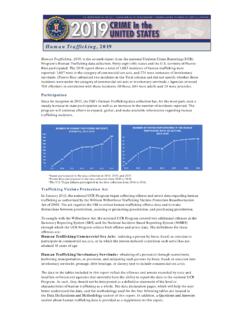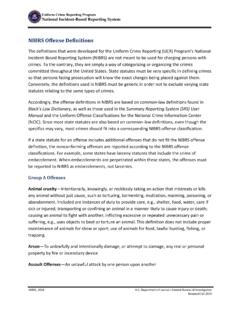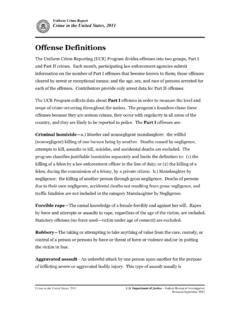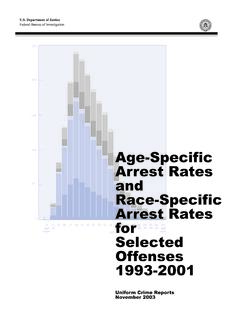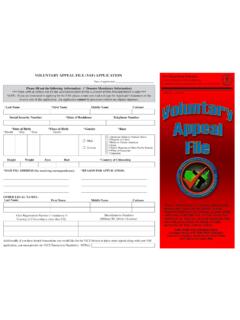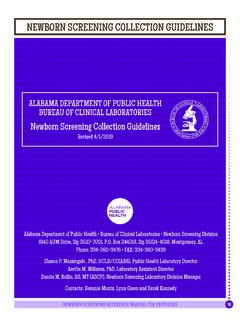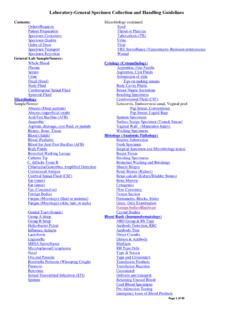Transcription of National Incident-Based Reporting System
1 Department of Justice Federal Bureau of Investigation Criminal Justice Information Services Division Uniform Crime Reporting National Incident-Based Reporting System Volume 1: Data collection guidelines August 2000 National Incident-Based Reporting System VOLUME 1: DATA collection guidelines Prepared by Department of Justice Federal Bureau of Investigation Criminal Justice Information Services Division Uniform Crime Reporting Program August 2000 FOREWORD Information about the National Incident-Based Reporting System ( nibrs ) is contained in the four documents described below: Volume 1: Data collection guidelines This document is for the use of local, state, and federal Uniform Crime Reporting (UCR) Program personnel ( , administrators, training instructors, report analysts, coders, data entry clerks, etc.)
2 Who are responsible for collecting and recording nibrs crime data for submission to the FBI. It contains a System overview and descriptions of the offenses, offense codes, reports, data elements, and data values used in the System . Volume 2: Data Submission Specifications This document is for the use of local, state, and federal systems personnel ( , computer programmers, analysts, etc.) who are responsible for preparing magnetic media for submission to the FBI. It contains the data submission instructions for magnetic media, record layouts, and error-handling procedures that must be followed in submitting magnetic media to the FBI for nibrs Reporting purposes. Volume 3: Approaches to Implementing an Incident-Based Reporting (IBR) System This document is for the use of local, state, and federal systems personnel ( , computer programmers, analysts, etc.)
3 Who are responsible for developing an IBR System that will meet nibrs s Reporting requirements. It contains suggested approaches to developing an IBR System , including a model incident report, standard data entry guide, data entry screens, and software design suggestions. This manual is being phased out. Copies will be available until the supply is depleted. Volume 4: Error Message Manual This document is for the use of local, state, and federal systems personnel ( , computer programmers, analysts, etc.) who are responsible for preparing magnetic media for submission to the FBI. It contains designations of mandatory and optional data elements, data element edits, and error messages. Copies of the above-listed documents can be obtained by writing to the: Communications Unit Criminal Justice Information Services Division Federal Bureau of Investigation Module D3 1000 Custer Hollow Road Clarksburg, West Virginia 26306-0154 facsimile 304-625-5394 iii CONTENTS I.
4 Overview 1 A. Purpose and Goals 1 B. Basis of guidelines and Specifications 1 C. Benefits of Participation 2 D. Requirements for Participation 3 E. Direct Versus Indirect Participation 4 F. Parallel Operation of nibrs and the Traditional UCR System 4 G. Major Differences Between nibrs and the Traditional UCR System 5 H. Miscellaneous Features of nibrs 16 II. Offenses 21 A. Criteria for Distinguishing Between Group A and B Offenses 21 B. Sources of Offense Definitions C. Group A Offense Definitions D. Group B Offense Definitions III. Offense Lookup Table A. Description of Lookup Table B. How to Classify Offenses of General Applicability C. Offense Lookup Table IV. Offense Codes A. Group A Offense Codes B. Group B Offense Codes C. Offense Code Table V. Reports A.
5 Group A Incident Report B. Group B Arrest Report C. Zero Report VI. Data Elements and Data Values A. Data Elements B. Data Values C. Descriptions of the Data Elements and Data Values 21 22 35 39 39 39 40 53 53 53 53 59 59 64 65 67 67 67 68 v VII. Mandatories 107 A. Data Element Requirements 107 B. Mandatory Versus Optional Data Elements 107 C. Required Data Values 108 D. Group A Incident Report - Common Data Elements 110 E. Group A Incident Report - Additional Data Elements 112 F. Group B Arrest Report Data Elements 120 vi I. OVERVIEW The following information is furnished to provide an overall description of the National Incident-Based Reporting System ( nibrs ), including its purpose, goals, development, and major features. A. Purpose and Goals Since the establishment of the Uniform Crime Reporting (UCR) Program in 1930, the volume, diversity, and complexity of crime steadily increased while the UCR Program remained virtually unchanged.
6 Recognizing the need to address crime s growing challenge, the law enforcement community in the late 1970s called for a thorough study of the UCR Program with the objective of revising the Program to meet law enforcement s needs into the twenty-first century. nibrs is the result of that study, and its purpose is to satisfy those needs. In order to ensure that it fulfills its purpose, nibrs has adopted the following goals: 1. To enhance the quantity, quality, and timeliness of crime statistical data collected by the law enforcement community. 2. To improve the methodology used for compiling, analyzing, auditing, and publishing the collected crime data. B. Basis of guidelines and Specifications The guidelines and specifications used in nibrs are based on the recommendations of Abt Associates Inc.
7 , as set forth in their report entitled Blueprint for the Future of the Uniform Crime Reporting Program, dated May 1985. Using the Blueprint s recommendations for general guidance, in January 1986 a private contractor and the FBI s Technical Services Division were assigned the task of developing the guidelines and design specifications for implementing a new Incident-Based System . Overall direction of the project was performed by the FBI s UCR staff. Advice was sought and received from the Association of State UCR Programs, International Association of Chiefs of Police, National Sheriffs Association, National Alliance of State Drug Enforcement Agencies, Drug Enforcement Administration, and various local, state, and federal criminal justice agencies. This collaboration was accomplished through formal conferences, informal meetings, and written and telephone contacts.
8 The advice received was of invaluable assistance in the preparation and refinement of the guidelines and specifications. The original version of the guidelines and specifications was provided to the South Carolina Law Enforcement Division (SLED), Columbia, South Carolina, for use in conducting a pilot demonstration of the workability of the proposed new System . Copies of the document 1 Overview were also provided to interested local and state law enforcement agencies to keep them apprised of the progress of the effort and to encourage their input into the redesign process. In order to conduct the pilot demonstration, SLED adapted its existing Incident-Based UCR System to operate in conformance with nibrs requirements. SLED also enlisted the cooperation of nine local law enforcement agencies, representing in relative terms the small, medium, and large departments in South Carolina, to participate in the project.
9 The pilot demonstration ran from March 1, 1987, until September 30, 1987, and resulted in further refinement of the guidelines and specifications. A National UCR conference was held on March 1 3, 1988, at Orange Beach, Alabama, to present the new System to law enforcement and obtain feedback on its acceptability. The overwhelming consensus of the attendees was that the FBI should continue its effort to implement the System nationally. The conference also generated additional suggestions for perfecting the System . Therefore, the guidelines and specifications for nibrs are the product of a long process of repeated review and practical testing. In the implementation of a System as large and as complex as nibrs , however, problems will require even more changes to the System .
10 Readers are encouraged to bring such problems to the attention of the FBI s UCR staff so that they can be resolved. It should be noted that most of the general concepts for collecting, scoring, and Reporting UCR data, as set forth in the Uniform Crime Reporting Handbook, remain applicable in nibrs just as they have since the establishment of the traditional UCR Program 70 years ago. For example, the jurisdictional rules for collecting data from the city, county, and state law enforcement agencies and the conditions under which a state UCR Program must operate remain the same. Rules for federal agencies have, however, now been added. The major differences between nibrs and the traditional UCR Summary System appear in subsection G on pages 5 16. The Uniform Crime Reporting Handbook, nibrs Edition provides a comprehensive look at nibrs and combines the old requirements retained from the traditional UCR Program with the new nibrs requirements.
